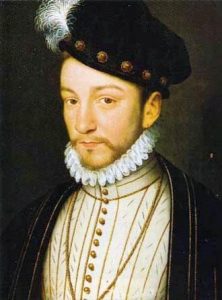Francis I of Valois (1494-1547)
The nephew of Louis XII was the symbolic king of the French Renaissance period, a humanist and founder of the Collège de France and builder of the castle in Chambord. He was almost constantly at war with Charles V, and won the battle of Marignan, but was defeated in Pavie, relinquishing the Milan region at the Peace of Cambrai in 1529. During his reign the ideas of Luther spread through France and were condemned by the Sorbonne as early as 1521. The first persecutions against the Protestants started. Francis I was authoritative and he strengthened his power over the great lords and the parliaments. He was rather tolerant concerning the Reformed ideas under the influence of his sister Marguerite d’Angoulème. The Affair of the Placards in 1534 and the injurious posters about the Catholic Church, convinced him to increase repression. He could not accept the secession of cities or regions for religious reasons, as Germany did. The massacre of the Waldensians in 1545 marked the last years of his reign.
Henri II of Valois (1519-1559)
He became king when 28 years old and pursued fighting the Hapsburgs. After winning Savoie and Piemont back, the defeat at Saint Quentin made him give them up for good. He increased repression against the Protestants and confiscated their properties. In 1540, he asked for the founding of a specific chamber in parliament, forbade emigration and closely watched printing. The 1551 Edict of Châteaubriant codified the different tortures. Henri II was mortally wounded at a tournament organised to celebrate peace with Philip II and the wedding of his daughter Elizabeth -”Isabella” in Spain. Considered by the people as the shield against the “Lutherans”, the death of the “knight-king” marked the beginning of chaos. None of his four sons, three of which succeeded one another on the French throne, had a male heir.
Catherine de Medici (1519-1589)
She was the daughter of Lorenzo II de Medici, Duke of Urbino. She married Henri II, king to be, in 1533. Widowed in 1559 she was regent from 1560 to 1563 during Charles IX’s minority. She played a key role all through the wars of religion. She promoted a policy of tolerance towards the Huguenots, especially with the Edict of January 1562. She was convinced that marriage covenants were important, so that her daughter Elizabeth married Philip II, and her daughter Claude married Charles III, Duke of Lorraine, and she decided her daughter Marguerite would marry Henri de Navarre. She was energetic and persisted in promoting agreement between the Protestants and the Catholics, but most importantly securing the royal authority. She defended the freedom of the Galllican Church, and was against the Council’s decisions to strengthen ecclesiastical courts of justice to judge the heretics, but also against the Pope who wanted to have French bishops accused of heresy tried by his own courts of justice. Considered by the Protestants having primary responsibility for the Saint-Bartholomew massacre, historians in the 19th century developed the dark legend of the foreigner with her Machiavellian Italian clique. More rigorous the present historiography has almost rehabilitated her.
Francis II of Valois (1544-1560)
Henri II’s eldest son succeeded him when he was 15. He was married to Mary Stuart, Queen of Scotland, and he let his wife’s Guise uncles rule the country. He died of chronic purulent otitis, probably “cholesteastoma.” During his eighteen-month reign the Protestants formed a political party, after failing to kidnap the king at the time of the “Amboise Conspiracy.”
Charles IX of Valois (1550-1574)
Henri II’s second son succeeded his brother when he was 10, so that his mother Catherine de Medici was appointed regent. The 4 first wars of religion took place during his reign, as well as the saint-Bartholomew massacre. He loved hunting, had an unpredictable character, an inconstant behaviour with an alternately violent and prudent behaviour towards the Protestants. He died of lung disease.
Henri III of Valois (1551-1589)
Unlike his brothers, Henri II’s third son became king as an adult in 1574. Already known as a military man after the siege of La Rochelle, Henri III was an intelligent good speaker, inclined to conciliation. He was frail, loved luxury, jewellery and dancing. To restore royal majesty, he established a strict regulated etiquette for the Court, putting the king above everybody. The royal entourage consisted of former comrades in arms, and of progressively promoted “Mignons”, namely Anne de Joyeuse and Jean-Louis de Nogaret de la Valette Duke of Epernon to be, who cumulated posts and honours. Henri III used them as guards against princes and nobility. Their elegance and the proofs of friendship granted by the king – which started the groundless accusations of homosexuality – bear witness to an ideal of harmony meant to elevate the royal stature. But the movement of the “Malcontents”, the manoeuvres of his brother Duke Francis of Alençon, pamphlets against the royal power, budget deficits, the assassination of Duke Henri of Guise, hesitations with the Protestants and reconciliation with Henri de Navarre, all precipitated his assassination.
Francis of Valois (1555-1584) duke of Alençon, then duke of Anjou
In 1574, Henri II’s fourth son became heir apparent to the crown after his brother Henri III was crowned. He was jealous of his brother and his ambition was to obtain the lieutenancy of the kingdom. He headed the Malcontent movement, set up several plots, especially after Charles IX’s death and before king Henri III came back from Poland. After failing to marry Elizabeth I of England, he was chosen by the Netherlands as protector of their freedom and became Duke of Brabant and Count of Flanders in 1580. His decision to take the city of Anvers by force was a failure and he had to retreat with his army. He died of Tuberculosis in 1584 without an heir, which left Henri of Navarre heir to the throne.








